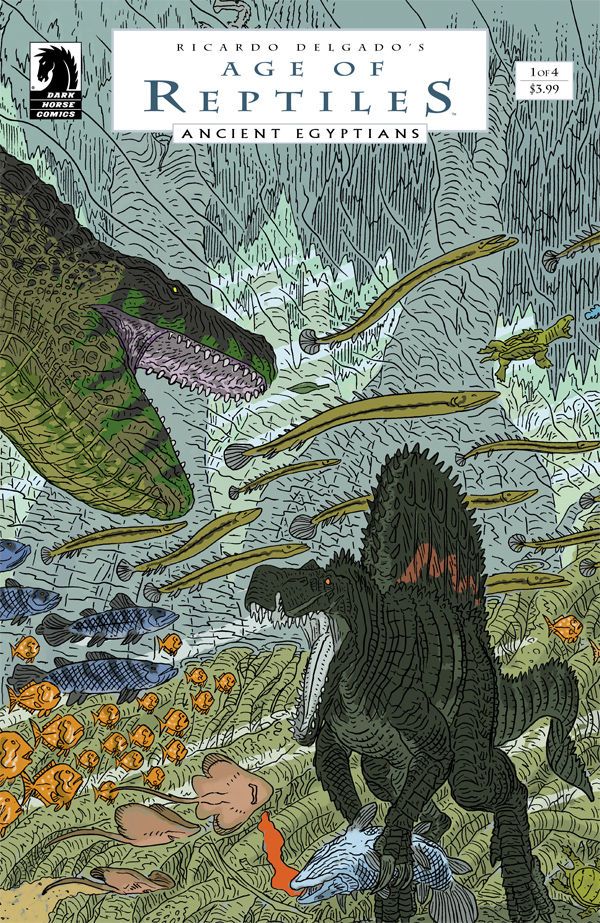Like previous "Age of Reptiles" series, "Age of Reptiles: Ancient Egyptians" #1 by Ricardo Delgado is a wordless story, told without dialogue, thought bubbles, textboxes or sound effects.
With an art-only vocabulary, Delgado takes care to make the action easy to follow. It helps that his storytelling approach always follows one main dinosaur throughout the arc. This time, the main character is a Spinosaurus aegyptiacus. Dark Horse's marketing describes the Spinosaurus as a "lonely antihero" and, while that description is anthropomorphic and over-the-top, it fits, much to my amusement.
The Spinosaurus wanders alone, relying only on its own wits, sporting impressive facial scars. It's a carnivorous predator, but its vulnerability to attack and its status as the point-of-view character prime the reader to root for it. It comes across as a plucky, smart narrator.
The action is linear, dotted with intermittent conflict but no hint of an overarching plot. Apart from some anthropomorphic facial expressions, it reads like a realistic day in the life of an animal. Delgado does a great job with the setting. In prehistoric times, Egypt wasn't covered by deserts but was instead more like Sub-Saharan East Africa is today. The climate is obvious from his backgrounds, but Delgado adds even more depth by using mist to give the impression of swampy, vaporous air and wet vegetation.
Reading it is akin to watching a nature documentary or being on a nature preserve, but without a wildlife guide or a voiceover by a scientist. Delgado has a strong grasp of pacing and panel flow, and his transitions are smooth.
Delgado's art doesn't have much line variation but he makes up for that with texture. He layers squiggles and smaller curved lines, which look great for the skin of reptiles, foliage and tree trunks. It's less successful with liquid surfaces, which look too choppy to be believable. It's also not ideal to capture reflective or iridescent surfaces like crustacean shells and ancient fish scales.
Hill's color work shows off the intricacy of Delgado's linework by layering only translucent, watercolor-like hues over the ink. He keeps the palette pale and naturalistic. There are reds, blues and greens, with some ochre yellows and browns mixed in, but no neons or other bright colors. The effect is calming. His technique keeps Delgado's fine details front and center, an approach that feels intentionally restrained and thoughtful.
As much as Hill's color work helps, the biggest visual drawback is the lack of depth. This seems to be part of Delgado's style. He uses no traditional shading. The light in his settings -- whether in the trees, under water or out in the open -- is always diffuse. Contrast is absent and Hill's colors only add a little dimension because of limited range of intensity in color. Delgado also doesn't foreground the dinosaurs. Every object within the panels gets the same level of intense textural detail. The result can look flat like a "Where's Waldo" landscape at times, but not unpleasantly so. The great variety of life he depicts doesn't get boring and also encourages the reader to imagine life from the Spinosaurus' perspective. Dinosaur fans will enjoy spotting different species, which are faithful to current knowledge based on the fossil record.
The plot has more spark and shape than one might expect. In addition to the Spinosaurus, other characters also show some personality, especially the Sauropods. One Sauropod steals the scene when his nostrils flare and he seems to inhale and snort in frustration or anger. Afterwards, the same Sauropod turns its head sideways, like a confused but alert human or a dog, when it spots the Spinosaurus hiding in the water. Delgado's skill with facial expression and body language makes this confrontation the highlight of the issue.
Whether it's realistic or not, it's unexpected to see the pack of Sauropods gang up on their oppressors. One doesn't expect a bunch of normally peaceful herbivores team up into defensive gang that aggressively fights their natural predators. This funny, surprising development adds a lot to the sparing plot.
"Age of Reptiles: Ancient Egyptians" #1 continues Delgado's strong work from previous "Age of Reptiles" series. It's an unorthodox reading experience that comfortably reproduces the rhythms of a wildlife film, but with dinosaurs instead of lions and giraffes. It's worth reading for its unusual balance of serenity and tension as it imagines the passage of time in a prehistoric world.

